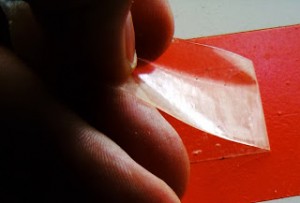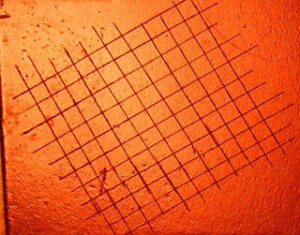Testing the Bond of an Ink or Paint
Whether you are screen printing or painting, the coating must bond to the substrate for the service life of the product. Depending on the physical properties of the coating that you have selected for a project and the substrate to which the coating will be applied, the paint or ink adheres in a few different manners.
Some paints and inks bond through absorption into the substrate. This is how a coating will typically adhere to a porous material, such as wood or paper. Other coatings adhere chemically. Solvent screen print inks will primarily bond to a plastic, such as a pressure sensitive film, by solvating or dissolving the surface and chemically uniting with the film. Finally, coating will adhere by mechanically interlocking with the surface of the substrate. The strength of a mechanical bond is greatly dependent on how the coating wets the surface.
Coatings often adhere to a substrate by employing more than one of the aforementioned adhesion mechanisms. Regardless of how a paint or ink forms its bond, its adhesion strength must be sufficient for the application for which it is being used or the coating will fail. Typical adhesion failures include peeling and blistering.
The importance of adhesion testing is to determine the strength of the bond before the job leaves your shop. That way you avoid the embarrassment when a job fails.
To test adhesion, people have devised a variety of tests. In performing some tests, coatings are scratched with either a thumb nail or knife. In other methods, tape is adhered to the coating and then pulled from the surface to determine if the bond of the paint or ink is adequate. More scientific procedures involve sophisticated equipment to more accurately record the performance of a coating.
Whatever tests that you select to determine how well a coating bonds to a substrate, what’s really important is that you perform some type of testing, irrespective of its complexity. The fact is that some of the simplest test procedures are often the best. These rudimentary tests generally provide all the information that a printer or painter needs in producing a quality product.
Thumb Nail Test. You can’t perform a more elemental test for ink adhesion than a thumb nail test. Although many technicians scoff at this procedure for its simplicity, it is nevertheless a quick and easy go/no go check. Here’s how it works.
After printing or painting some sample pieces of film or substrate, allow the coating to completely cure. In conducting these tests, you should cure the coating using the same method as will be used in production.
Then simply scratch the surface of the ink with your thumbnail. A properly cured ink will resist scratching. Painters will do a variation of this test, scraping the coating with the blade of a utility knife.
Thumb Twist Test. Another simple test is the thumb twist test. In this test, just press your thumb against the ink or paint and give it a twist. If the ink is not thoroughly cured, a hardened layer of ink can slip over an uncured layer of ink. A properly cured coating also should not feel tacky. Instead it should feel dry to the touch.
Although the Thumb Twist and the Thumbnail test methods are regarded by some as being very subjective in nature and dependent on the skill and experience of the individual, these tests can alert printers to potential adhesion problems.
Cross Hatch Test. Your testing should include a cross hatch test to check the adhesion of the ink to the substrate; intercoat adhesion (the bond of one layer of a coating to another) and compatibility of the coating with the substrate or another coating.
The cross hatch test consists of lightly scoring the printed ink sample or paint sample eleven times with an X-Acto® knife and then scoring the ink again the same number of times over the first set of lines at a 90° angle. The cross hatch pattern of parallel lines should be approximately 1/8” (.32 cm) apart. For about $500 or $600 you can also buy a cross hatch tester. This tools has blades evenly spaced and at a uniform depth.
After cutting the lines, use a plastic squeegee to burnish an aggressive tape, such as 3M Brand #600 clear tape, over the scored cutlines. The tape is then pulled off 180° against itself, in one quick motion. If any of the ink comes off, the adhesion of the ink to the substrate is insufficient.

Burnish an aggressive tape over the scored cutlines. Then pull the tape off in one quick motion at a 180° angle against itself .
A variation of the cross hatch test is the Cross Cut Test. Using an X-Acto® knife you lightly score the surface with two knife cuts forming an “X”. After applying an aggressive tape over the cut and quickly ripping it from the surface at a 180° angle against itself, you should check the substrate and the tape for any paint or ink, which may have been removed. This test checks whether the coating is secure to the surface. Coatings, which have not formed a strong bond, are prone to peeling.
Conclusion. The tests that I have described obviously are not the only way to test the adhesion of a coating. Other tests have been developed. Some involve expensive laboratory equipment. The popularity of the cross hatch test is its simplicity and its reliability. It is an easy test which can be performed either on the line or in the lab.
Once you find a combination of raw materials that work for you, that you stick with that winning formula. You should document the details of every job, so that nothing is left to chance when duplicating a reorder. Repeatability of results depends largely on reproducing all of the variables involved in printing or painting.




